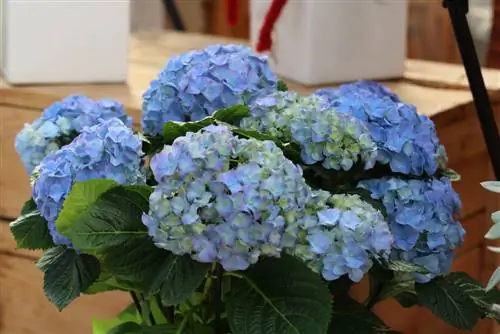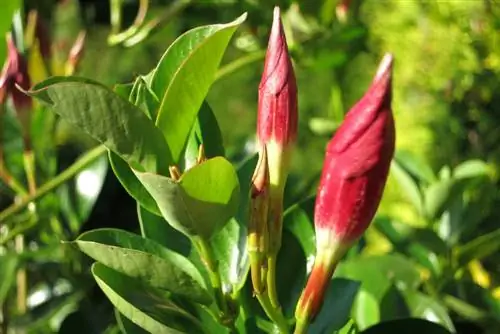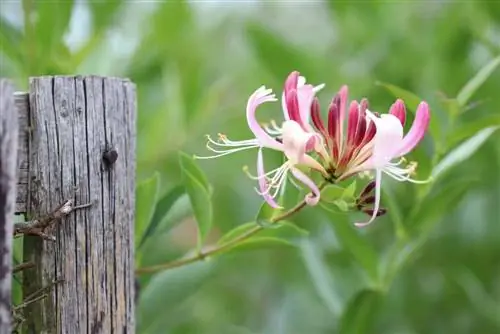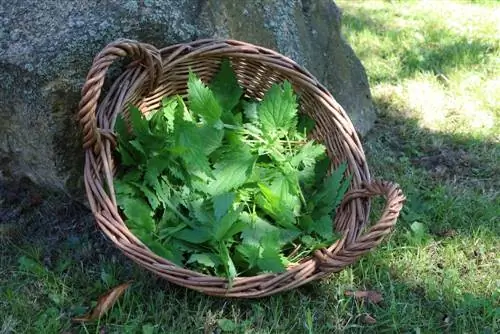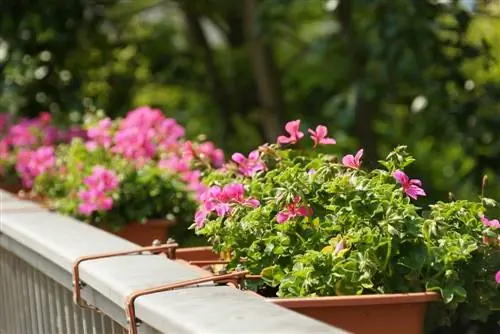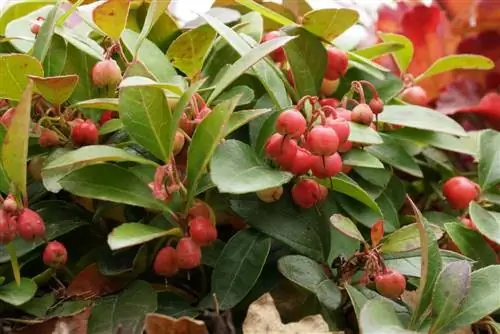- Author admin [email protected].
- Public 2023-12-17 03:39.
- Last modified 2025-01-24 12:45.
Just like with houseplants, potted plants also need to be given a larger pot and fresh potting soil every now and then. Because of their size, this isn't as easy to do as with a small houseplant, but with the right knowledge and a few tricks it's actually quite easy. The right time to repot is spring after winter dormancy. Young plants need to be repotted annually in the first few years, older ones only if the root ball is too strong. If potted plants were repotted before being moved to their winter quarters, the nutrients in the fresh potting soil could ensure that the plant sprouts.
How do you repot potted plants?
When people have to move, they experience it as stressful and exhausting. Moving to a new pot and the associated changes also means stress for potted plants. It should therefore be carried out and prepared as gently as possible. These are the items you should have ready when a plant needs to be repotted:
- fresh potting soil of good quality, preferably potted plant soil
- a new pot that is 2 cm wider than the previous one
- sharp secateurs to trim the roots
- old newspapers or foil
- Potter shard, expanded clay or polystyrene beads as a drainage layer
Gardening gloves not only protect your hands from dirt, they also offer a little more safety if the potted plants have thorns like roses or bougainvillea or sharp-edged lancet leaves like some palm trees. They shouldn't be too big and should fit well so that you have the right support. Once everything has been laid out, you can get started. It is important that the plant is not exposed to strong temperature differences during the repotting process. So if possible, don't move from the warm winter garden to the cold terrace to repot, just to avoid dirtying the room or to have more space.
Turn the plant and pot upside down and touch it directly on the surface of the soil. By gently tapping the bottom of the pot, the plant, including the root ball and old soil, should be removed from the pot. If not, you can also press the side of the pot a little, if it is made of clay, tap it a little harder against the bottom of the pot or give it a quick jerk on a soft surface. If all else fails, you should use scissors on plastic pots to cut the pot open. Clay pots can then only be smashed. The shards can then be used for drainage in other pots. Once the plant has been freed from the old pot, part two of the action follows.
Transferring into new soil and a larger pot
If it is a young plant that is to be repotted, the existing soil around the roots does not need to be removed. The new pot should have a diameter that is 2 cm larger and high enough that the plant can still be placed with about 5 cm of space to the top edge of the pot. Old potted plants are probably so heavily rooted that the roots that stick out of the pot should definitely be cut off. It's worth getting the old soil out from between the roots and cutting back the roots that have become too long.

The new pot - if it is made of clay - is watered sufficiently. This way it can absorb moisture and not immediately pull it out of the new potting soil. Then a piece of clay is placed over the drain hole of the pot and a layer of potting soil is filled into it. This can be done up to a third of the height of the pot, but after planting the plant there should still be enough space to the top. The new soil is now filled around the plant and distributed thoroughly between the roots. This is easier if the pot is shaken briefly and gently every now and then. There should be enough space up to the top edge so that the water cannot simply run over it.
Tip:
The new garden soil was mixed with fertilizer, a new dose is not necessary immediately.
Fertilizer can be added later either with liquid fertilizer in the irrigation water or with fertilizer balls or cones. These are long-term fertilizers and release the nutrients into the potting soil over weeks. A trivet under the pot catches the excess water and keeps it ready as a small reserve. This is particularly pleasant in summer because the potting soil in the pot does not dry out so quickly. In the cool season, however, it can cause some plants to get cold feet.
When the potted plant is in its new soil in the new flower pot, it should be watered thoroughly. The warmer the temperatures, the more water it initially needs. A few portions of water may be necessary until all of the new soil in the flower pot is moistened. The plant should also not be placed in the blazing sun straight away, as it first has to recover from the action and get used to its new pot.
Conclusion & useful information about repotting potted plants
If potted plants have a dense and matted ball, they can cope with it for a while, but not permanently. If it goes one step further and the roots start to rot or the soil becomes acidic, then it is very important to act quickly and repot the potted plants.
- The ideal time for repotting is spring, as this means you can get the plants into shape in time before they bloom.
- You can tell that repotting is necessary when the soil is compacted or the roots start to grow out of the pot.
- Then it is clear that the roots no longer have room in the flower pot and urgently need more space.
When repotting, you should not only make sure that the new flower pot is big enough, but that it also has a hole on the bottom. Basically, for the he althy growth of potted plants, it is necessary that there is a water drain, because potted plants don't like waterlogging.
Which type of bucket you choose depends on your personal taste. There are flower pots made of terracotta, ceramic, wood or even plastic. If the potted plants are very large and therefore heavy, you should also buy a plant roller and place the flower pot and its contents on it. On the one hand, you can quickly transport the plant to another location and on the other hand, it ensures perfect drainage of the irrigation water.
- The new soil for repotting should have a crumbly structure and also be airy and resistant to shedding.
- If not included in the substrate from the start, you should mix gravel, lava granules or even clay balls into the soil.
- A few shards of pottery are then placed on the hole in the middle of the flower pot. This will prevent the hole from becoming clogged with soil.
- If the potted plant to be transplanted has a very overgrown ball, you should let it dry for a few days first, as this makes it easier to remove it from the plastic pot.
- The incrustations and protruding roots are then removed from the ball with a knife.
- Afterwards, the old soil is removed as best as possible and the bale is then placed in the new flower pot.
- The first watering should then be done very thoroughly so that the fresh soil can settle.

